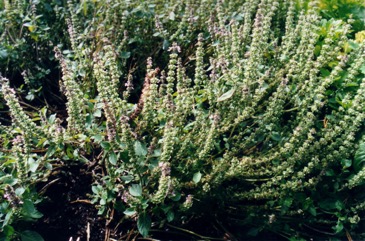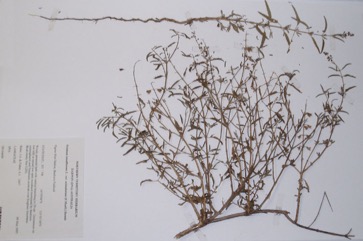Holy basil, Bush tea leaf, Sacred Basil

It is a warm temperate plant. It needs a sunny sheltered position. Soil should be kept moist. In Asia it grows up to 600 m altitude. In China it grows in dry sandy areas. It can grow in arid places. In Hobart Botanical gardens. It suits hardiness zones 9-10.
Also known as:
Ajaka, Aring, Baranda, Basilic des moines, Basilic sacre, Bidai, Brinda, Bryanda, Fusthula, Gaggera, Hsiang tsai, Kadiring, Kala-pi-sein, Kala tulsi, Kalitulshin, Kamangi, Kaphrao, Katriin, Kom ko dong, Krishna tulasi, Lamar, Loko-loko, Maeng-luk, Manjari, M'reas prov, Mreah preu, Mreahs prow, Nalla tulasi, Parnasa, Patrapuspha, Phak ka phao, Pin-sein-net, Ruku fuik, Ruku-ruku, Sacred balm, Saph'au, Sheng luo le, Sulasi, Suvasa tulasi, Tarp hao, Te marou, Thai basil, Trittavu, Tulasa, Tulasi chajadha, Tulsi, Tunrusi, Warung
Synonyms
- Lumnitzera tenuiflora (L.) Spreng.
- Ocimum anisodorum F. Muell.
- Ocimum brachiatum Hassk.
- Ocimum caryophyllinum F. Muell.
- Ocimum flexuosum Blanco
- Ocimum hirsutum Benth.
- Ocimum inodorum Burm. f.
- Ocimum monachorum L.
- Ocimum sanctum L
- Ocimum sanctum L. var. angustifolium Benth.
- Ocimum sanctum L. var. cubensis Gomes
- Ocimum scutellarioides Willd. ex Benth.
- Ocimum subserratum B. Heyne ex Hook. f.
- Ocimum tenuiflorum L. f. villicaulis Domin
- Ocimum tenuiflorum L. var. anisodorum (F. Muell.) Domin.
- Ocimum tomentosum Lam.
- Ocimum villosum Roxb.
- Moschosma tenuiflorum (L.) Heyne.
- Geniosporum tenuiflorum (L.) Merr.
- Plectranthus monachorum (L.) Spreng.
Edible Portion
- Leaves for tea, Herb, Seeds, Spice, Flowers
Where does Holy basil grow?
Found in: Andamans, Africa, Asia, Australia, Bangladesh, Cambodia, Caroline Islands, China, Chuuk, Cook Islands, Cuba, Dominican Republic, East Africa, East Timor, Ethiopia, Fiji, FSM, Hawaii, Himalayas, India, Indochina, Indonesia, Kenya, Kiribati, Laos, Malaysia, Maldives, Marquesas, Marshall Islands, Micronesia, Myanmar, Nauru, Nepal, Pacific, Pakistan, Papua New Guinea, PNG, Philippines, Pohnpei, Rotuma, SE Asia, Solomon Islands, Sri Lanka, Taiwan, Tasmania, Tanzania, Thailand, Timor-Leste, Tuvalu, United States, Vanuatu, Vietnam, West Indies, Yap
Notes: There are between 100 and 150 Ocimum species. It has anticancer properties.
Status: The seeds are sold in markets. It is a sacred plant within Hinduism. It is eaten in larger amounts during famines.
Growing Holy basil, Bush tea leaf, Sacred Basil
Cultivation: It is grown from seed. Seeds are sown directly.
Edible Uses: The soft seeds when soaked in water give a drink. The leaves are used for flavouring. They are used to flavour fruit jellies, sweet breads and preserves. The fresh leaves can be added to salads. They are also used as a substitute for tea. The flowers are eaten.
Production: Leaves suffer cold injury if stored below 12°C after harvest.
Nutrition Info
per 100g edible portion| Edible Part | Energy (kcal) | Protein (g) | Iron (mg) | Vitamin A (ug) | Vitamin c (mg) | Zinc (mg) | % Water |
|---|---|---|---|---|---|---|---|
| - | - | - | - | - | - |
Holy basil, Bush tea leaf, Sacred Basil Photos


References
Ambasta, S.P. (Ed.), 2000, The Useful Plants of India. CSIR India. p 405 (As Ocimum sanctum)
Awasthi, A.K., 1991, Ethnobotanical studies of the Negrito Islanders of Andaman Islands, India - The Great Andamanese. Economic Botany 45(2) pp274-280 (As Ocimum sanctum)
Anderson, E. F., 1993, Plants and people of the Golden Triangle. Dioscorides Press. p 216 (As Ocimum sanctum)
Anon., 2003, Native Plants for the Fitzroy basin. Society for Growing Australian Plants Inc. (Rockhampton Branch) p 69
Bremness, L., 1994, Herbs. Collins Eyewitness Handbooks. Harper Collins. p 260 (As Ocimum sanctum)
Burkill, I.H., 1966, A Dictionary of the Economic Products of the Malay Peninsula. Ministry of Agriculture and Cooperatives, Kuala Lumpur, Malaysia. Vol 2 (I-Z) p 1602 (As Ocimum sanctum)
Burnie, G & Fenton-Smith, J., 1999, A Grower's Guide to Herbs. Murdoch Books. p 12 (As Ocimum sanctum)
Cheifetz, A., (ed), 1999, 500 popular vegetables, herbs, fruits and nuts for Australian Gardeners. Random House p 143
Cowie, I, 2006, A Survey of Flora and vegetation of the proposed Jaco-Tutuala-Lore National Park. Timor-Lests (East Timor) www.territorystories.nt/gov.au p 49 (var. anisodorum)
Creasy, R., 2000, The Edible Asian Garden. Periplus p 23 (As Ocimum sanctum)
Cribb, A.B. & J.W., 1976, Wild Food in Australia, Fontana. p 175 (As Ocimum sanctum)
Cundall, P., (ed.), 2004, Gardening Australia: flora: the gardener's bible. ABC Books. p 944
Dangol, D. R. et al, 2017, Wild Edible Plants in Nepal. Proceedings of 2nd National Workshop on CUAOGR, 2017. (As Ocimum sanctum)
Dhyani, S.K., & Sharma, R.V., 1987, Exploration of Socio-economic plant resources of Vyasi Valley in Tehri Garwhal. J. Econ. Tax. Bot. Vol. 9 No. 2 pp 299-310 (As Ocimum sanctum)
Elliot, W.R., & Jones, D.L., 1997, Encyclopedia of Australian Plants suitable for cultivation. Vol 7. Lothian. p 60
Facciola, S., 1998, Cornucopia 2: a Source Book of Edible Plants. Kampong Publications, p 131
Flora of Pakistan. www.eFloras.org
Franklin, J., Keppel, G., & Whistler, W., 2008, The vegetation and flora of Lakeba, Nayau and Aiwa Islands, Central Lau Group, Fiji. Micronesica 40(1/2): 169–225, 2008
French, B.R., 2010, Food Plants of Solomon Islands. A Compendium. Food Plants International Inc. p 353
Gouldstone, S., 1983, Growing your own Food-bearing Plants in Australia. Macmillan p 187 (As Ocimum sanctum)
Hibbert, M., 2002, The Aussie Plant Finder 2002, Florilegium. p 213
Hussey, B.M.J., Keighery, G.J., Cousens, R.D., Dodd, J., Lloyd, S.G., 1997, Western Weeds. A guide to the weeds of Western Australia. Plant Protection Society of Western Australia. p 170
Jadhav, R., et al, 2015, Forest Foods of Northern Western Ghats: Mode of Consumption, Nutrition and Availability. Asian Agri-History Vol. 19, No. 4: 293-317
Japanese International Research Centre for Agricultural Science www.jircas.affrc.go.jp/project/value_addition/Vegetables
Lawton, B.P., 2002, Mints. A Family of Herbs and Ornamentals. Timber Press, Portland, Oregon. p 165
Lazarides, M. & Hince, B., 1993, Handbook of Economic Plants of Australia, CSIRO. p 172 (As Ocimum sanctum)
Lazarides, M. & Hince, B., 1993, Handbook of Economic Plants of Australia, CSIRO. p 172
Lembogi Biologi Nasional, 1980, Sayur-sayuran. Balai Pustaka, Jakarta. p 102 (As Ocimum sanctum)
Li Hai-wen, Hedge, I.C., Lamiaceae. Flora of China. p 397 (As Ocimum sanctum)
Low, T., 1992, Bush Tucker. Australia’s Wild Food Harvest. Angus & Robertson. p 178
Luczaj, L., et al, 2021, Wild food plants and fungi sold in the markets of Luang Prabang, Lao PDR. Journal of Ethnobiology and Ethnomedicine (2021) 17:6
Martin, F.W. & Ruberte, R.M., 1979, Edible Leaves of the Tropics. Antillian College Press, Mayaguez, Puerto Rico. p 196 (As Ocimum sanctum)
McMakin, P.D., 2000, Flowering Plants of Thailand. A Field Guide. White Lotus. p 94 (As Ocimum sanctum)
Molla, A., Ethiopian Plant Names. http://www.ethiopic.com/aplants.htm
Ocho, D. L., et al, 2012, Assessing the levels of food shortage using the traffic light metaphor by analyzing the gathering and consumption of wild food plants, crop parts and crop residues in Konso, Ethiopia. Journal of Ethnobiology and Ethnomedicine 8:30
Paczkowska, G. & Chapman, A.R., 2000, The Western Australian Flora. A Descriptive Catalogue. Western Australian Herbarium. p 275
Peekel, P.G., 1984, (Translation E.E.Henty), Flora of the Bismarck Archipelago for Naturalists, Division of Botany, Lae, PNG. p 491,
Phon, P., 2000, Plants used in Cambodia. © Pauline Dy Phon, Phnom Penh, Cambodia. p 477
Purseglove, J.W., 1968, Tropical Crops Dicotyledons, Longmans. p 636 (As Ocimum sanctum)
Royal Botanic Gardens, Kew (1999). Survey of Economic Plants for Arid and Semi-Arid Lands (SEPASAL) database. Published on the Internet; http://www.rbgkew.org.uk/ceb/sepasal/internet [Accessed 19th April 2011]
Smith, A.C., 1991, Flora Vitiensis Nova, Lawaii, Kuai, Hawaii, Volume 5 p 230
Smith, K & I., 199, Grow your own bushfoods. New Holland. Australia. p 9
Solomon, C., 2001, Encyclopedia of Asian Food. New Holland. p 24 (As Ocimum sanctum)
Sp. pl. 2:597. 1753
Staples, G.W. and Herbst, D.R., 2005, A tropical Garden Flora. Bishop Museum Press, Honolulu, Hawaii. p 359
Sujanapal, P., & Sankaran, K. V., 2016, Common Plants of Maldives. FAO & Kerala FRI, p 184
Terra, G.J.A., 1973, Tropical Vegetables. Communication 54e Royal Tropical Institute, Amsterdam, p 64 (As Ocimum sanctum)
Thaman, R. R., 1987, Plants of Kiribati: A listing and analysis of vernacular names. Atoll Research Bulletin No. 296 (As Ocimum sanctum)
Thaman, R. R, 2016, The flora of Tuvalu. Atoll Research Bulletin No. 611. Smithsonian Institute p 95
Thapa, L. B., et al, 2014, Wild Edible Plants used by endangered and Indigenous Raji Tribe in Western Nepal. International Journal of Applied Sciences and Biotechnology. Vol 2(3):243-252 (As Ocimum sanctum)
Thomson, G. & Morgan, W., (Ed.) 2001, Access to Asian Foods Newsletter, Vic Govt., Australia Issue 36
Turreira Garcia, N., et al, 2017, Ethnobotanical knowledgeof the Kuy and Khmer people in Prey Lang, Cambodia. Cambodian Journal of Natural History 2017 (1): 76-101
van Wyk, B., 2005, Food Plants of the World. An illustrated guide. Timber press. p 265
Walter, A. & Lebot, V., 2007, Gardens of Oceania. ACIAR Monograph No. 122. p 279
Wheeler, J.R.(ed.), 1992, Flora of the Kimberley Region. CALM, Western Australian Herbarium, p 807
Wightman, G. & Andrews, M., 1991, Bush Tucker Identikit. Common Native Food Plants of Australia’s top end. Conservation Commission Northern Territory. p 60
Wightman, Glenn et al. 1992, Mangarrayi Ethnobotany: Aboriginal Plant Use from the Elsey Area Northern Australia. Northern Territory Botanical Bulletin No 15. Parks and Wildlife Commission of the Northern Territory. p 38, 37.
Woodward, P., 2000, Asian Herbs and Vegetables. Hyland House. p 103
World Checklist of Useful Plant Species 2020. Royal Botanic Gardens, Kew
www.manoa.hawaii.edu/botany/plants of micronesia.